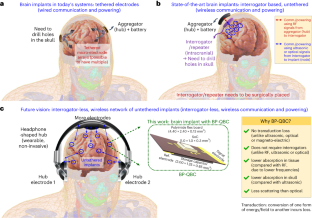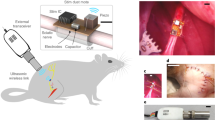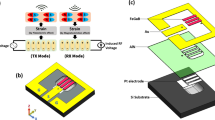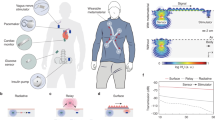Abstract
Wearable devices typically use electromagnetic fields for wireless information exchange. For implanted devices, electromagnetic signals suffer from a high amount of absorption in tissue, and alternative modes of transmission (ultrasound, optical and magneto-electric) cause large transduction losses due to energy conversion. To mitigate this challenge, we report biphasic quasistatic brain communication for wireless neural implants. The approach is based on electro-quasistatic signalling that avoids transduction losses and leads to an end-to-end channel loss of only around 60 dB at a distance of 55 mm. It utilizes dipole-coupling-based signal transfer through the brain tissue via differential excitation in the transmitter (implant) and differential signal pickup at the receiver (external hub). It also employs a series capacitor before the signal electrode to block d.c. current flow through the tissue and maintain ion balance. Since the electrical signal transfer through the brain is electro-quasistatic up to the several tens of megahertz, it provides a scalable (up to 10 Mbps), low-loss and energy-efficient uplink from the implant to an external wearable. The transmit power consumption is only 0.52 μW at 1 Mbps (with 1% duty cycling)—within the range of possible energy harvesting in the downlink from a wearable hub to an implant.
This is a preview of subscription content, access via your institution
Access options
Access Nature and 54 other Nature Portfolio journals
Get Nature+, our best-value online-access subscription
$29.99 / 30 days
cancel any time
Subscribe to this journal
Receive 12 digital issues and online access to articles
$119.00 per year
only $9.92 per issue
Buy this article
- Purchase on Springer Link
- Instant access to full article PDF
Prices may be subject to local taxes which are calculated during checkout






Similar content being viewed by others
Data availability
The data that support the plots within this paper and other findings of this study are available via GitHub at https://github.com/WISE-Lab-UF/NatE23_BP-QBC. Further details can be obtained from the corresponding authors upon reasonable request. Source data are provided with this paper.
Code availability
Custom codes used to process the data are available via GitHub at https://github.com/WISE-Lab-UF/NatE23_BP-QBC. Further details can be obtained from the corresponding authors upon reasonable request.
References
Chen, Z., Xi, J., Huang, W. & Yuen, M. F. Stretchable conductive elastomer for wireless wearable communication applications. Sci. Rep. 7, 10958 (2017).
Huang, X. et al. Highly flexible and conductive printed graphene for wireless wearable communications applications. Sci. Rep. 5, 18298 (2015).
Rabaey, J. M. The human intranet—where swarms and humans meet. IEEE Pervasive Comput. 14, 78–83 (2015).
Hessar, M., Iyer, V. & Gollakota, S. Enabling on-body transmissions with commodity devices. In Proc. 2016 ACM International Joint Conference on Pervasive and Ubiquitous Computing 1100–1111 (ACM, 2016).
Interfacing with the Brain (accessed 25 December 2021); https://neuralink.com/approach/
Lee, J. et al. Neural recording and stimulation using wireless networks of microimplants. Nat. Electron. 4, 604–614 (2021).
Borton, D. et al. An implantable wireless neural interface for recording cortical circuit dynamics in moving primates. J. Neural Eng. 10, 026010 (2013).
Lim, J. et al. A 0.19×0.17mm2 wireless neural recording IC for motor prediction with near-infrared-based power and data telemetry. In Proc. 2020 IEEE International Solid-State Circuits Conference (ISSCC) Digest of Technical Papers (ed Fujino, L. C.) 63, 416–418 (IEEE, 2020).
Ghanbari, M. et al. A 0.8mm3 ultrasonic implantable wireless neural recording system with linear AM backscattering. In Proc. 2019 IEEE International Solid-State Circuits Conference (ISSCC) Digest of Technical Papers (ed Fujino, L. C.) 62, 284–286 (IEEE, 2019).
Yu, Z. et al. An 8.2 mm3 implantable neurostimulator with magnetoelectric power and data transfer. In Proc. 2020 IEEE International Solid-State Circuits Conference (ISSCC) Digest of Technical Papers (ed Fujino, L. C.) 63, 510–512 (IEEE, 2020).
Jia, Y. et al. A mm-sized free-floating wirelessly powered implantable optical stimulating system-on-a-chip. In Proc. 2018 IEEE International Solid-State Circuits Conference (ISSCC) Digest of Technical Papers (ed Fujino, L. C.) 61, 468–470 (IEEE, 2018).
Lo, Y. et al. A 176-channel 0.5cm3 0.7 g wireless implant for motor function recovery after spinal cord injury. In Proc. 2016 IEEE International Solid-State Circuits Conference (ISSCC) Digest of Technical Papers (ed Fujino, L. C.) 59, 382–383 (IEEE, 2016).
Lee, J. et al. An implantable wireless network of distributed microscale sensors for neural applications. In Proc. 2019 International IEEE/EMBS Conference on Neural Engineering (NER) 871–874 (IEEE, 2019).
ICNIRP Guidelines for Limiting Exposure to Time-Varying Electric, Magnetic and Electromagnetic Fields (accessed 5 Feb 2022); https://www.icnirp.org/cms/upload/publications/ICNIRPemfgdl.pdf
IEEE standard for safety levels with respect to human exposure to radio frequency electromagnetic fields, 3 kHz to 300 GHz. In IEEE Std C95.1-2005 (Revision of IEEE Std C95.1-1991) 1–238 (IEEE, 2006).
IEEE standard for safety levels with respect to human exposure to electromagnetic fields, 0-3 kHz. In IEEE Std C95.6-2002 1–64 (IEEE, 2002).
Modak, N., Nath, M., Chatterjee, B., Maity, S. & Sen, S. Bio-physical modeling of galvanic human body communication in electro-quasistatic regime. IEEE Trans. on Biomed. Eng. 69, 3717–3727 (2022).
Datta, A., Nath, M., Yang, D. & Sen, S. Advanced bio-physical model to capture channel variability for EQS capacitive HBC. IEEE Trans. Biomed. Eng. 68, 3435–3446 (2021).
Lecture Notes|Electromagnetic Energy: From Motors to Lasers|Electrical Engineering and Computer Science|MIT OpenCourseWare (accessed 15 March 2021); https://ocw.mit.edu/courses/electrical-engineering-and-computer-science/6-007-electromagnetic-energy-from-motors-to-lasers-spring-2011/lecture-notes/
Larsson, J. Electromagnetics from a quasistatic perspective. Am. J. Phys. 75, 230–239 (2007).
Tissue Properties (accessed 25 December 2021); https://itis.swiss/virtual-population/tissue-properties/database/dielectric-properties/
Gabriel, S., Lau, R. W. & Gabriel, C. The dielectric properties of biological tissues: III. Parametric models for the dielectric spectrum of tissues. Phys. Med. Biol. 41, 2271 (1996).
Zimmerman, T. G. Personal area networks: near-field intrabody communication. IBM Syst. J. 35, 609–617 (1996).
Oberle, M. Low Power Systems-on-Chip for Biomedical Applications. PhD thesis, ETH Zurich (2002).
Hachisuka, K. et al. Development of wearable intra-body communication devices. Sens. Actuators Phys. 105, 109–115 (2003).
Cho, N. et al. The human body characteristics as a signal transmission medium for intrabody communication. IEEE Trans. Microw. Theory Tech. 55, 1080–1086 (2007).
Yanagida, T. Human body communication system and communication device. US patent 7664476B2 (2010).
Xu, R., Zhu, H. & Yuan, J. Electric-field intrabody communication channel modeling with finite-element method. IEEE Trans. Biomed. Eng. 58, 705–712 (2011).
Lucev, Ž., Krois, I. & Cifrek, M. A capacitive intrabody communication channel from 100 kHz to 100 MHz. IEEE Trans. Instrum. Meas. 61, 3280–3289 (2012).
Bae, J., Cho, H., Song, K., Lee, H. & Yoo, H. The signal transmission mechanism on the surface of human body for body channel communication. IEEE Trans. Microw. Theory Tech. 60, 582–593 (2012).
Park, J., Garudadri, H. & Mercier, P. P. Channel modeling of miniaturized battery-powered capacitive human body communication systems. IEEE Trans. Biomed. Eng. 64, 452–462 (2017).
Cho, H. et al. A 79 pJ/b 80 Mb/s full-duplex transceiver and a 42.5 µW 100 kb/s super-regenerative transceiver for body channel communication. IEEE J. Solid-State Circuits 51, 310–317 (2016).
Maity, S., Chatterjee, B., Chang, G. & Sen, S. Bodywire: a 6.3pJ/b 30Mb/s –30dB SIR-tolerant broadband interference-robust human body communication transceiver using time domain interference rejection. IEEE J. Solid-State Circuits 54, 2892–2906 (2019).
Maity, S. et al. Bio-physical modeling, characterization, and optimization of electro-quasistatic human body communication. IEEE Trans. Biomed. Eng. 66, 1791–1802 (2019).
Li, J. et al. Human-body-coupled power-delivery and ambient-energy-harvesting ICs for a full-body-area power sustainability. In Proc. IEEE International Solid-State Circuits Conference (ISSCC) Digest of Technical Papers (ed Fujino, L. C.) 63, 514–515 (IEEE, 2020).
Yuk, B. et al. An implantable body channel communication system with 3.7-pJ/b reception and 34-pJ/b transmission efficiencies. IEEE Solid-State Circuits Lett. 3, 50–53 (2020).
Li, J. et al. Body-coupled power transmission and energy harvesting. Nat. Electron. 4, 530–538 (2021).
Lee, C. et al. A miniaturized wireless neural implant with body-coupled data transmission and power delivery for freely behaving animals. In Proc. 2022 IEEE International Solid-State Circuits Conference (ISSCC) Digest of Technical Papers (ed Fujino, L. C.) 65, 1–3 (IEEE, 2022).
Chatterjee, B. et al. A 65 nm 63.3 µW 15 Mbps transceiver with switched-capacitor adiabatic signaling and combinatorial-pulse-position modulation for body-worn video-sensing AR nodes. In Proc. 2022 IEEE International Solid-State Circuits Conference (ISSCC) Digest of Technical Papers (ed Fujino, L. C.) 65, 276–278 (IEEE, 2022).
Wegmueller, M. S., Oberle, M., Felber, N., Kuster, N. & Fichtner, W. Signal transmission by galvanic coupling through the human body. IEEE Trans. Instrum. Meas. 59, 963–969 (2010).
Callejón, M. A., Naranjo-Hernández, D., Reina-Tosina, J. & Roa, L. M. A. Comprehensive study into intrabody communication measurements. IEEE Trans. Instrum. Meas. 62, 2446–2455 (2013).
Datta, A. et al. A quantitative analysis of physical security and path loss with frequency for IBOB channels. IEEE Microw. Wireless Compon. Lett. 32, 792–795 (2022).
Zhao, Z. et al. Ionic communication for implantable bioelectronics. Sci. Adv. 8, 50–53 (2022).
Chatterjee, B. et al. A 1.15μW 5.54mm3 implant with a bidirectional neural sensor and stimulator SoC utilizing bi-phasic quasistatic brain communication achieving 6kbps-10Mbps uplink with compressive sensing and RO-PUF based collision avoidance. In Proc. 2021 IEEE Symposium on VLSI Circuits 1–2 (IEEE, 2021).
Das, D., Maity, S., Chatterjee, B. & Sen, S. Enabling covert body area network using electro-quasistatic human body communication. Sci. Rep. 9, 4160 (2019).
NEVA Electromagnetics (accessed 5 February 2022); https://www.nevaelectromagnetics.com/
Specific Absorption Rate (SAR) (accessed 17 June 2023); https://www.fcc.gov/general/specific-absorption-rate-sar-cellular-telephones#:~:text=The%20FCC%20limit%20for%20public
Roberts, N. et al. A 236nW –56.5dBm-sensitivity Bluetooth low-energy wakeup receiver with energy harvesting in 65nm CMOS. In Proc. 2016 IEEE International Solid-State Circuits Conference (ISSCC) Digest of Technical Papers (ed Fujino, L. C.) 59, 382–383 (IEEE, 2016).
Kumar, G. K., Chatterjee, B & Sen, S. CS-Audio: A 16 pJ/b 0.1-15Mbps compressive sensing IC with DWT sparsifier for audio-AR. IEEE J. Solid-State Circuits 57, 2220–2235 (2022).
Sen, O. & Chatterjee, B. Modified ring-oscillator physical unclonable function (RO-PUF) based PRBS generation as a device signature in distributed brain implants. In Proc. 2023 IEEE International Midwest Symposium on Circuits and Systems (MWSCAS) in press (IEEE, 2023).
MakeHuman|Open Source Tool for Making 3D Characters (accessed 26 April 2022); http://www.makehuman.org/license.php
RF Explorer (accessed 17 June 2023); http://j3.rf-explorer.com/
Maity, S. et al. Sub-μWRComm: 415-nW 1–10-kb/s physically and mathematically secure electro-quasi-static HBC node for authentication and medical applications. IEEE J. Solid-State Circuits 56, 788–802 (2021).
Acknowledgements
This work was supported by the Air Force Office of Scientific Research YIP Award (FA9550-17-1-0450, to S.S.), the National Science Foundation CAREER Award (grant no. 1944602, to S.S.) and the National Science Foundation CRII Award (CNS 1657455, to S.S.). We would like to thank D. Das (Purdue University) and N. Modak (Purdue University) for their co-operation and support during the development of the ICs for the neural node. The experiments in K.J. lab were supported by a Purdue Institute for Integrative Neuroscience seed grant.
Author information
Authors and Affiliations
Contributions
B.C. and S.S. conceived the idea. B.C., S.S. and M.N. contributed to the design of the experiments for BP-QBC. B.C., M.N., G.K.K. and S.S. conducted the theoretical analysis, numerical simulations and node design, as well as performed the characterization experiments. B.C., S.X., K.J. and G.K.K. performed the in vitro and in vivo animal experiments. B.C., S.S., M.N. and K.J. analysed the experimental data. B.C., M.N. and S.S. wrote the paper. All the authors contributed to reviewing and revising the manuscript.
Corresponding authors
Ethics declarations
Competing interests
The authors declare no competing interests.
Peer review
Peer review information
Nature Electronics thanks Cong Ding and the other, anonymous, reviewer(s) for their contribution to the peer review of this work.
Additional information
Publisher’s note Springer Nature remains neutral with regard to jurisdictional claims in published maps and institutional affiliations.
Supplementary information
Supplementary Information
Supplementary Notes 1–3, Figs. 1 and 2 and Table 1.
Source data
Source Data Fig. 3c
Raw data for the plots.
Source Data Fig. 3d
Raw data for the plots.
Source Data Fig. 4
Raw data for the plots.
Source Data Fig. 5c,d
Raw data for the plots.
Source Data Fig. 5f
Raw data for the plots.
Source Data Fig. 6b
Raw data for the plots.
Source Data Fig. 6f
Raw data for the plots.
Rights and permissions
Springer Nature or its licensor (e.g. a society or other partner) holds exclusive rights to this article under a publishing agreement with the author(s) or other rightsholder(s); author self-archiving of the accepted manuscript version of this article is solely governed by the terms of such publishing agreement and applicable law.
About this article
Cite this article
Chatterjee, B., Nath, M., Kumar K, G. et al. Biphasic quasistatic brain communication for energy-efficient wireless neural implants. Nat Electron 6, 703–716 (2023). https://doi.org/10.1038/s41928-023-01000-3
Received:
Accepted:
Published:
Issue Date:
DOI: https://doi.org/10.1038/s41928-023-01000-3



